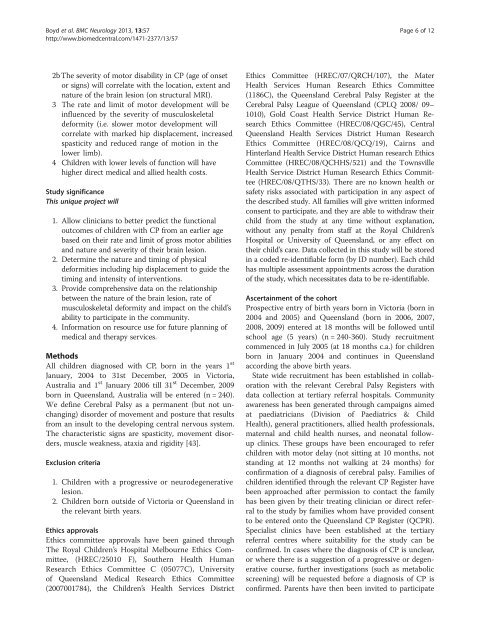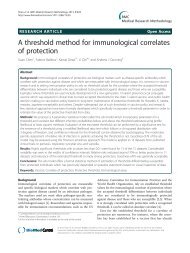Australian Cerebral Palsy Child Study: protocol of ... - BioMed Central
Australian Cerebral Palsy Child Study: protocol of ... - BioMed Central
Australian Cerebral Palsy Child Study: protocol of ... - BioMed Central
Create successful ePaper yourself
Turn your PDF publications into a flip-book with our unique Google optimized e-Paper software.
Boyd et al. BMC Neurology 2013, 13:57 Page 6 <strong>of</strong> 12<br />
http://www.biomedcentral.com/1471-2377/13/57<br />
2bThe severity <strong>of</strong> motor disability in CP (age <strong>of</strong> onset<br />
or signs) will correlate with the location, extent and<br />
nature <strong>of</strong> the brain lesion (on structural MRI).<br />
3 The rate and limit <strong>of</strong> motor development will be<br />
influenced by the severity <strong>of</strong> musculoskeletal<br />
deformity (i.e. slower motor development will<br />
correlate with marked hip displacement, increased<br />
spasticity and reduced range <strong>of</strong> motion in the<br />
lower limb).<br />
4 <strong>Child</strong>ren with lower levels <strong>of</strong> function will have<br />
higher direct medical and allied health costs.<br />
<strong>Study</strong> significance<br />
This unique project will<br />
1. Allow clinicians to better predict the functional<br />
outcomes <strong>of</strong> children with CP from an earlier age<br />
based on their rate and limit <strong>of</strong> gross motor abilities<br />
and nature and severity <strong>of</strong> their brain lesion.<br />
2. Determine the nature and timing <strong>of</strong> physical<br />
deformities including hip displacement to guide the<br />
timing and intensity <strong>of</strong> interventions.<br />
3. Provide comprehensive data on the relationship<br />
between the nature <strong>of</strong> the brain lesion, rate <strong>of</strong><br />
musculoskeletal deformity and impact on the child’s<br />
ability to participate in the community.<br />
4. Information on resource use for future planning <strong>of</strong><br />
medical and therapy services.<br />
Methods<br />
All children diagnosed with CP, born in the years 1 st<br />
January, 2004 to 31st December, 2005 in Victoria,<br />
Australia and 1 st January 2006 till 31 st December, 2009<br />
born in Queensland, Australia will be entered (n = 240).<br />
We define <strong>Cerebral</strong> <strong>Palsy</strong> as a permanent (but not unchanging)<br />
disorder <strong>of</strong> movement and posture that results<br />
from an insult to the developing central nervous system.<br />
The characteristic signs are spasticity, movement disorders,<br />
muscle weakness, ataxia and rigidity [43].<br />
Exclusion criteria<br />
1. <strong>Child</strong>ren with a progressive or neurodegenerative<br />
lesion.<br />
2. <strong>Child</strong>ren born outside <strong>of</strong> Victoria or Queensland in<br />
the relevant birth years.<br />
Ethics approvals<br />
Ethics committee approvals have been gained through<br />
The Royal <strong>Child</strong>ren’s Hospital Melbourne Ethics Committee,<br />
(HREC/25010 F), Southern Health Human<br />
Research Ethics Committee C (05077C), University<br />
<strong>of</strong> Queensland Medical Research Ethics Committee<br />
(2007001784), the <strong>Child</strong>ren’s Health Services District<br />
Ethics Committee (HREC/07/QRCH/107), the Mater<br />
Health Services Human Research Ethics Committee<br />
(1186C), the Queensland <strong>Cerebral</strong> <strong>Palsy</strong> Register at the<br />
<strong>Cerebral</strong> <strong>Palsy</strong> League <strong>of</strong> Queensland (CPLQ 2008/ 09–<br />
1010), Gold Coast Health Service District Human Research<br />
Ethics Committee (HREC/08/QGC/45), <strong>Central</strong><br />
Queensland Health Services District Human Research<br />
Ethics Committee (HREC/08/QCQ/19), Cairns and<br />
Hinterland Health Service District Human research Ethics<br />
Committee (HREC/08/QCHHS/521) and the Townsville<br />
Health Service District Human Research Ethics Committee<br />
(HREC/08/QTHS/33). There are no known health or<br />
safety risks associated with participation in any aspect <strong>of</strong><br />
the described study. All families will give written informed<br />
consent to participate, and they are able to withdraw their<br />
child from the study at any time without explanation,<br />
without any penalty from staff at the Royal <strong>Child</strong>ren’s<br />
Hospital or University <strong>of</strong> Queensland, or any effect on<br />
their child’s care. Data collected in this study will be stored<br />
in a coded re-identifiable form (by ID number). Each child<br />
has multiple assessment appointments across the duration<br />
<strong>of</strong> the study, which necessitates data to be re-identifiable.<br />
Ascertainment <strong>of</strong> the cohort<br />
Prospective entry <strong>of</strong> birth years born in Victoria (born in<br />
2004 and 2005) and Queensland (born in 2006, 2007,<br />
2008, 2009) entered at 18 months will be followed until<br />
school age (5 years) (n = 240-360). <strong>Study</strong> recruitment<br />
commenced in July 2005 (at 18 months c.a.) for children<br />
born in January 2004 and continues in Queensland<br />
according the above birth years.<br />
State wide recruitment has been established in collaboration<br />
with the relevant <strong>Cerebral</strong> <strong>Palsy</strong> Registers with<br />
data collection at tertiary referral hospitals. Community<br />
awareness has been generated through campaigns aimed<br />
at paediatricians (Division <strong>of</strong> Paediatrics & <strong>Child</strong><br />
Health), general practitioners, allied health pr<strong>of</strong>essionals,<br />
maternal and child health nurses, and neonatal followup<br />
clinics. These groups have been encouraged to refer<br />
children with motor delay (not sitting at 10 months, not<br />
standing at 12 months not walking at 24 months) for<br />
confirmation <strong>of</strong> a diagnosis <strong>of</strong> cerebral palsy. Families <strong>of</strong><br />
children identified through the relevant CP Register have<br />
been approached after permission to contact the family<br />
has been given by their treating clinician or direct referral<br />
to the study by families whom have provided consent<br />
to be entered onto the Queensland CP Register (QCPR).<br />
Specialist clinics have been established at the tertiary<br />
referral centres where suitability for the study can be<br />
confirmed. In cases where the diagnosis <strong>of</strong> CP is unclear,<br />
or where there is a suggestion <strong>of</strong> a progressive or degenerative<br />
course, further investigations (such as metabolic<br />
screening) will be requested before a diagnosis <strong>of</strong> CP is<br />
confirmed. Parents have then been invited to participate
















